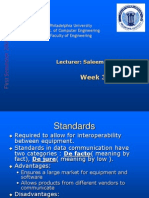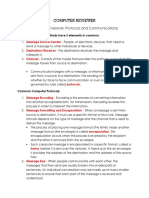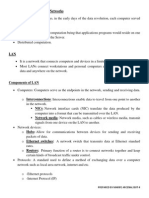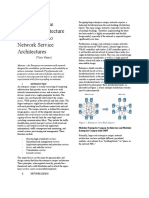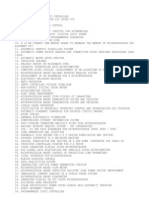Cambridge International AS and A Level Computer Science: Topic Support Guide
Uploaded by
TrynosCambridge International AS and A Level Computer Science: Topic Support Guide
Uploaded by
TrynosTopic support guide
Cambridge International AS and A Level
Computer Science
9608
For examination from 2017
Topic 3.2.1 Protocols
Cambridge International Examinations retains the copyright on all its publications.
Registered Centres are permitted to copy material from this booklet for their own
internal use. However, we cannot give permission to Centres to photocopy any
material that is acknowledged to a third party even for internal use within a Centre.
© Cambridge International Examinations 2016
Version 1
Contents
Introduction ..................................................................................................................................... 2
How to use this guide .................................................................................................................. 2
Learning objectives ..................................................................................................................... 2
Prior knowledge........................................................................................................................... 2
1. Key terms ................................................................................................................................ 3
2. Theory ..................................................................................................................................... 4
2.1 What is a protocol? ................................................................................................................ 4
2.2 Layering and the OSI model .................................................................................................. 5
2.3 TCP/IP................................................................................................................................... 6
2.4 The TCP/IP layer model ........................................................................................................ 7
2.5 A TCP/IP communication example ........................................................................................ 8
3. Online resources...................................................................................................................... 9
3.1 Websites ............................................................................................................................... 9
4. Class and homework activities ............................................................................................... 10
4.1 Quiz ..................................................................................................................................... 10
4.2 Homework questions ........................................................................................................... 11
Topic support guide 9608 Topic 3.2.1 Protocols 1
Introduction
Introduction
How to use this guide
The aim of this guide is to facilitate your teaching of the Cambridge International AS and A Level
Computer Science topic 3.2.1 Protocols, part of the advanced theory topic 3.2 Communication and
internet technologies. This guide concentrates on the learning objectives relating to protocols and
the TCP/IP protocol suite. The guidance and activities in this resource are designed to help
teachers devise programmes of study which provide teaching time devoted to theory work as well
as activities that consolidate learning.
Section 1 lists some key terms used in this topic and their definitions. Section 2 introduces
protocols, the OSI model and the TCP/IP protocol suite. Section 3 lists some online resources that
you or your learners may find useful, Section 4 gives ideas for class and homework activities.
Learning objectives
Using this document should help you guide learners in the following syllabus learning objectives:
show understanding of why a protocol is essential for communication between computers
show understanding of how protocol implementation can be viewed as a stack, where each
layer has its own functionality
show understanding of the function of each layer of the TCP/IP protocol suite
show understanding of the application of the TCP/IP protocol suite when a message is sent
from one host to another on the internet.
Prior knowledge
Before you begin teaching this topic you should:
understand what protocols are and why they are needed for communication
be familiar with the OSI seven-layer model
be familiar with the TCP/IP protocol suite and how the functions of the layers
compare to those of the OSI model
understand how the TCP/IP protocol implements data communication between
host computers connected to the internet.
2 Topic support guide 9608 Topic 3.2.1 Protocols
Key terms
1. Key terms
Word/phrase Meaning
Internet A protocol that specifies the size of the packets that a message is broken down
Protocol (IP) into, and the address of the recipient device
IPv4 A method of addressing that uses 32-bit numbers to specify internet/network
addresses
IPv6 A method of addressing that uses 128-bit numbers to specify internet/network
addresses
layer A division of the OSI and TCP/IP models that contains a protocol that
implements a specific aspect of communication
OSI model A model that defines standards for communication between any two devices
and across any network
protocol A set of rules governing communication between computers
Transmission A protocol in the TCP/IP suite that handles the transfer of data from one
Control computer to another
Protocol (TCP)
TCP/IP Layer A model that defines standards for communication over the internet
Model
TCP/IP suite A collection of protocols including IP, TCP and UDP that handles
communication between two computers across the internet
User Datagram A protocol in the TCP/IP suite that broadcasts data across a network
Protocol (UDP)
Topic support guide 9608 Topic 3.2.1 Protocols 3
Theory
2. Theory
2.1 What is a protocol?
Modern computers are designed with communication in mind. At a basic level, computers may
need to communicate with peripherals such as a printer, or to send messages to other computers,
which may be connected across a local area network (such as in a business, or a school), a mobile
phone cellular network, or the internet.
Before one computer can communicate with another, there must be a set of agreed rules in place
that manage how the communication is to take place. These rules are known collectively as a
protocol.
To illustrate the need for rules when two or more objects communicate, we will look at some rules
used when humans talk to each other. For example, we:
use sound to send messages
use a common language that we both understand
listen when the other person is talking, so we can hear them speak
speak at a rate that allows us to clearly transmit words and receive them
have ways of checking that the other person has heard what we have said.
Without such rules, communication becomes difficult, or even impossible.
Similarly to human communication, computers use rules, and these form the protocols that are
used for computer communication. Protocols need to specify several aspects of communication,
for example:
the communication medium to be used, such as wired or wireless
the transmission type, such as duplex or simplex
whether the handshake is hardware or software in nature
the method of error checking to be used
the bit rate
the character set that will be used.
The protocols allow messages to be transmitted in a structured, specific manner, so that the
receiving device is able to process the data sent from the sending device. Protocols therefore
make sure that communication between any two devices is successful. Different communication
protocols exist to specify rules for different types of communication, for example:
Hyper Text Transfer Protocol (HTTP) – handles transmission of data to and from a website
Simple Mail Transfer Protocol (SMTP) – handles email transmission
File Transfer Protocol (FTP) – handles transmission of files across a network
TCP/IP – handles communication over the internet.
4 Topic support guide 9608 Topic 3.2.1 Protocols
Theory
2.2 Layering and the OSI model
Many types of computer – for example, personal computers, laptops, servers, tablets and
smartphones – exist, and they are made by many different manufacturers. As a result, it is
important to have standards in place that designers and equipment manufacturers can follow to
make sure their products can communicate with others’.
The Open Systems Interconnection model (OSI model) was introduced to form standards for
computer communication. The model takes the various elements of communication and
conceptually separates them into layers. Each layer can be treated individually, and is independent
from the others. Each layer contains different protocols and handles a different part of the
transmission.
The model specifies seven layers:
Layer Description
Application Layer The interface between applications and the
network. Data/messages from applications are
passed down to / received from the Presentation
Layer.
Presentation Layer Converts the data/message passed down from the
Application Layer into a format usable by the
layers below. Applications use data in different
ways and in different formats. This layer makes
sure all data/messages are standardised into one
format.
Session Layer Controls the communication. Every communication
has a beginning and an end. The Session Layer
initiates the communication and maintains it until it
is terminated.
Transport Layer Orders and assembles data packets for
transmission across the network.
Network Layer Delivers packets. This layer determines the
address of the destination computer and works out
a route for packets to be sent across the network.
Data Link Layer Aids error-free transmission. This layer contains
the error-checking rules and attempts to correct
any transmission errors, as well as determining the
flow rate. Devices may not be able to communicate
at the same speed, so this layer makes sure data
flows at a rate acceptable for both devices.
Physical Layer Handles the physical characteristics of the
hardware that handles the communication, such as
the medium (e.g. wired or wireless) and
transmission type.
Topic support guide 9608 Topic 3.2.1 Protocols 5
Theory
The layers are numbered and sit one above each other, and can therefore be thought of as a
stack. The output from one layer provides the input for the next. Each layer interacts only with the
layer directly above it and/or below it, and at the bottom of the stack, the Physical Layer transmits
data between the source and destination devices:
7. Application Layer
6. Presentation Layer
5. Session Layer
4. Transport Layer
3. Network Layer
2. Data Link Layer
1. Physical Layer
Dividing protocols into layers provides several benefits:
Different media (e.g. wired and wireless) are able to use the same protocols in most layers
above the Physical Layer. This makes it easier for a manufacturer to introduce a new
transmission medium.
Similarly, when testing new equipment, developers only have to test the layers that contain
protocols specific to that equipment (e.g. for a new router, testing would be needed at the
Network Layer, but not the Transport Layer).
Protocols are sometimes updated, and as the layers are separate and independent, the rules
within them can be changed without affecting the rules contained in the other layers, as long as
the interface to the layers above and below is kept the same.
Transmission faults are more easily traced, as the type of error is often specific to a layer. A
tester only has to investigate that layer to find the cause of the problem.
2.3 TCP/IP
The development and growth of the internet required specific protocols for internet communication.
Two protocols – Internet Protocol (IP) and Transmission Control Protocol (TCP) – were developed
as a result. Known collectively as the TCP/IP suite, each protocol is responsible for different
aspects of communication:
6 Topic support guide 9608 Topic 3.2.1 Protocols
Theory
Internet communication uses ‘packet switching’ to handle data transfers from the sending
device to the receiving device – that is, transferred data, such as a downloaded file, is not sent
across the network in a single message, but is broken down into ‘packets’ of smaller pieces of
data. IP specifies the size of the packets that the message is broken down into, and the
address of the receiving device.
TCP handles the transfer of data between the sending and receiving devices – the ‘end-to-end’
communication. It establishes a connection, then makes sure the packets are sent and
received correctly and in the right order. If a packet does not arrive, TCP re-sends the packet.
TCP differs from some other networking protocols in that it does not broadcast data across a
network – instead it is used for one-to-one communication between two devices. Another
protocol, the User Datagram Protocol (UDP) is used for broadcasting data. Unlike TCP, UDP
does not guarantee the packet will safely arrive.
2.3.1 IP addresses
The Internet Protocol version 4 (IPv4) uses 32-bit numbers to specify internet addresses. These
addresses are broken down into four numbers in the range 0 to 255, and they are separated by a
dot. For example:
192.168.0.1
Each number is converted to 8 bits:
192 . 168 . 0 . 1
11000000 . 10101000 . 00000000 . 00000001
The four 8-bit numbers form one 32-bit number:
11000000101010000000000000000001
However, using 32 bits limits the total possible number of internet addresses to 4,294,967,296 (232)
addresses (4.3 billion). Although this appears to be a very large number, the huge number of
computer devices currently running in the world means that the number of free addresses is
running out. As a result, a new version of the protocol, IPv6, using 128 bits, is now also in use. This
gives 2128 possible addresses!
2.4 The TCP/IP layer model
The TCP/IP layer model pre-dates the OSI model, but shares similarities. Whereas the OSI model
contains seven layers, the TCP/IP model has just four. The following table shows how the TCP/IP
layers map to the OSI model layers:
TCP/IP model OSI model
Application Layer
Application Layer Presentation Layer
Session Layer
Transport Layer Transport Layer
Internet Layer Network Layer
Network Interface Layer Data Link Layer
Physical Layer
Topic support guide 9608 Topic 3.2.1 Protocols 7
Theory
The TCP/IP layers handle similar communication rules compared to their OSI model equivalents:
Layer Description
Application Layer The interface between applications (e.g. file
transfer, e-mail, web browsing) and the
network. Data/messages from applications
are passed to / received from the Transport
Layer.
Transport Layer Orders and assembles data packets for
transmission across the network. The
Transmission Control Protocol resides in this
layer, as does the User Datagram Protocol.
Internet Layer Exchanges packets between networks,
making all connected individual networks
appear as one big network. The Internet
Protocol is the main protocol in this layer.
Network Interface Layer Defines how to transfers packets between
adjacent nodes on a wide area network and
within a local area network.
2.5 A TCP/IP communication example
If we want to view a webpage on the internet, the TCP/IP suite handles the communication
between our device and the webpage’s webserver:
1. Our browser uses the Hyper Text Transfer Protocol (HTTP) to send a request to the Application
Layer.
2. The Application Layer protocol (HTTP) sends the request to the Transmission Control Protocol
(TCP) in the Transport Layer. The TCP communicates with the Internet Layer to establish a
connection with the webserver across the network(s).
3. The Internet Protocol in the Internet Layer establishes the address of the webserver and
converts the request into packets. The packets are sent to the Network Layer.
4. The Network Layer uses its protocols to send the packets over the internet to the webserver.
5. At the webserver the process is reversed. The packets are sent up through the protocols in the
layers, and re-assembled into the request. The request is passed through the Application Layer
protocols for the webserver to service.
6. In the same manner the webserver uses the protocols in the layers to send the webpage data
back to our device.
8 Topic support guide 9608 Topic 3.2.1 Protocols
Online resources
3. Online resources
The following are useful resources for understanding protocols.
The content of websites is dynamic and constantly changing. Schools are strongly advised to check
each site for content and accessibility prior to using it with learners. Cambridge International
Examinations is not responsible for the accuracy or content of information contained in these sites.
The inclusion of a link to an external website should not be understood to be an endorsement of
that website or the site's owners (or their products/services).
3.1 Websites
Scottish Qualifications Authority Higher National Computing website – covers most areas of the
topic, including the OSI model, TCP/IP, IPv4 and IPv6, and includes some useful diagrams:
www.sqa.org.uk/e-learning/HardOSEss04CD/index.htm
An alternative explanation of the OSI model, including example technologies and protocols for
each layer:
http://compnetworking.about.com/od/osimodel/tp/The-Seven-Layers-of-the-OSI-Model-
Illustrated.htm
Explanation, using examples, of the TCP/IP protocol:
www.hardwaresecrets.com/how-tcp-ip-protocol-works-part-1/
Topic support guide 9608 Topic 3.2.1 Protocols 9
Class and homework activities
4. Class and homework activities
4.1 Quiz
1. A protocol is:
a. a message sent from one computer to another
b. a program used to send messages between computers
c. a set of rules governing communication between computers
2. The OSI Model was developed to:
a. allow communication between two devices
b. define standards for communication
c. allow communication over the internet
3. An advantage of layering is:
a. transmission faults are easier to trace
b. computers can communicate without error
c. the transmission medium can be specified
4. The purpose of the Transmission Control Protocol is to:
a. allow packets to be sent over a network
b. allow packets to be sent over the internet
c. specify packet sizes and allocate packet numbers
5. The purpose of the Internet Protocol is to:
a. determine the address of the recipient computer
b. allow packets to be sent over the internet
c. specify the transmission medium
10 Topic support guide 9608 Topic 3.2.1 Protocols
Class and homework activities
4.2 Homework questions
1. Explain how protocols allow communication between computers
2. Describe three advantages of layering
3. Explain the purpose of the TCP and IP protocols
Topic support guide 9608 Topic 3.2.1 Protocols 11
You might also like
- Chapter 3-Protocols and Models - Part I(1)No ratings yetChapter 3-Protocols and Models - Part I(1)18 pages
- Protocol and Standard in Computer NetworksNo ratings yetProtocol and Standard in Computer Networks4 pages
- W3 Module Network Protocols and CommunicationNo ratings yetW3 Module Network Protocols and Communication11 pages
- 2-Module 1 - Overview of Computer and Communication Networks-08-12-2022No ratings yet2-Module 1 - Overview of Computer and Communication Networks-08-12-202229 pages
- Install and manage network protocols-Short noteNo ratings yetInstall and manage network protocols-Short note37 pages
- Chapter 3. Network Protocols and CommunicationsNo ratings yetChapter 3. Network Protocols and Communications58 pages
- 2-Introduction To Computer Network-03-01-2024No ratings yet2-Introduction To Computer Network-03-01-202423 pages
- Installandmanagenetworkprotocols 221219130255 40dcfff3No ratings yetInstallandmanagenetworkprotocols 221219130255 40dcfff338 pages
- Protocol and Standard in Computer NetworksNo ratings yetProtocol and Standard in Computer Networks4 pages
- Networking Programming with C++: Build Efficient Communication SystemsFrom EverandNetworking Programming with C++: Build Efficient Communication SystemsNo ratings yet
- Communications Protocol: From Wikipedia, The Free Encyclopedia100% (1)Communications Protocol: From Wikipedia, The Free Encyclopedia21 pages
- Chapter-02 Network Models and Protocol Suites (2)No ratings yetChapter-02 Network Models and Protocol Suites (2)38 pages
- Data Communications and Networks (IT-213) : Spring 2021No ratings yetData Communications and Networks (IT-213) : Spring 202159 pages
- Python Networking Essentials: Building Secure and Fast NetworksFrom EverandPython Networking Essentials: Building Secure and Fast NetworksNo ratings yet
- Computer Reviewer: (Chapter 3: Network Protocols and Communications)No ratings yetComputer Reviewer: (Chapter 3: Network Protocols and Communications)9 pages
- Chapter 1 Part A: Data Communications and Networks OverviewNo ratings yetChapter 1 Part A: Data Communications and Networks Overview79 pages
- Section 4 Further Problem-Solving and Programming SkillsNo ratings yetSection 4 Further Problem-Solving and Programming Skills26 pages
- GSM Communicator G17F Installation ManualNo ratings yetGSM Communicator G17F Installation Manual16 pages
- Industrial Control Systems (ICS) and SCADA Cyber Security TrainingNo ratings yetIndustrial Control Systems (ICS) and SCADA Cyber Security Training31 pages
- Compactblock I/O For Devicenet: Technical DataNo ratings yetCompactblock I/O For Devicenet: Technical Data36 pages
- Large Enterprise Network Architecture Design 1No ratings yetLarge Enterprise Network Architecture Design 14 pages
- Getting in The SS7 Kingdom: Hard Technology and Disturbingly Easy Hacks To Get Entry Points in The Walled Garden0% (1)Getting in The SS7 Kingdom: Hard Technology and Disturbingly Easy Hacks To Get Entry Points in The Walled Garden44 pages
- Islamic University in Uganda: Department of Computer Faculty of ScienceNo ratings yetIslamic University in Uganda: Department of Computer Faculty of Science34 pages
- Cisco Nexus 5000 Series NX-OS Software Configuration Guide - Configuring VLANs (Cisco Nexus 5000 Series Switches) - CiscoNo ratings yetCisco Nexus 5000 Series NX-OS Software Configuration Guide - Configuring VLANs (Cisco Nexus 5000 Series Switches) - Cisco4 pages
- Important Instructions To Examiners:: Enlist Four Advantages of LANNo ratings yetImportant Instructions To Examiners:: Enlist Four Advantages of LAN27 pages
- Service Description BT Ethernet ConnectNo ratings yetService Description BT Ethernet Connect18 pages
- Configuration Manual: Cab Label PrintersNo ratings yetConfiguration Manual: Cab Label Printers65 pages
- 2-Module 1 - Overview of Computer and Communication Networks-08-12-20222-Module 1 - Overview of Computer and Communication Networks-08-12-2022
- Installandmanagenetworkprotocols 221219130255 40dcfff3Installandmanagenetworkprotocols 221219130255 40dcfff3
- Internet Protocols: Concepts and ArchitecturesFrom EverandInternet Protocols: Concepts and Architectures
- Networking Programming with C++: Build Efficient Communication SystemsFrom EverandNetworking Programming with C++: Build Efficient Communication Systems
- Communications Protocol: From Wikipedia, The Free EncyclopediaCommunications Protocol: From Wikipedia, The Free Encyclopedia
- Data Communications and Networks (IT-213) : Spring 2021Data Communications and Networks (IT-213) : Spring 2021
- Python Networking Essentials: Building Secure and Fast NetworksFrom EverandPython Networking Essentials: Building Secure and Fast Networks
- Computer Reviewer: (Chapter 3: Network Protocols and Communications)Computer Reviewer: (Chapter 3: Network Protocols and Communications)
- Chapter 1 Part A: Data Communications and Networks OverviewChapter 1 Part A: Data Communications and Networks Overview
- Section 4 Further Problem-Solving and Programming SkillsSection 4 Further Problem-Solving and Programming Skills
- Industrial Control Systems (ICS) and SCADA Cyber Security TrainingIndustrial Control Systems (ICS) and SCADA Cyber Security Training
- Getting in The SS7 Kingdom: Hard Technology and Disturbingly Easy Hacks To Get Entry Points in The Walled GardenGetting in The SS7 Kingdom: Hard Technology and Disturbingly Easy Hacks To Get Entry Points in The Walled Garden
- Islamic University in Uganda: Department of Computer Faculty of ScienceIslamic University in Uganda: Department of Computer Faculty of Science
- Cisco Nexus 5000 Series NX-OS Software Configuration Guide - Configuring VLANs (Cisco Nexus 5000 Series Switches) - CiscoCisco Nexus 5000 Series NX-OS Software Configuration Guide - Configuring VLANs (Cisco Nexus 5000 Series Switches) - Cisco
- Important Instructions To Examiners:: Enlist Four Advantages of LANImportant Instructions To Examiners:: Enlist Four Advantages of LAN








































